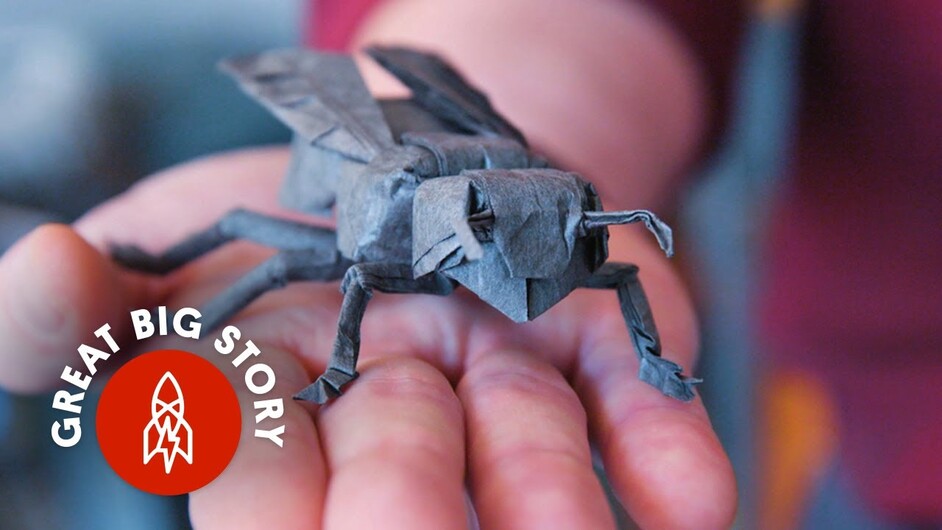Saw this today and thought some of you might enjoy.
wonder how »easy« it would be to score the folds for origami with a glowforge.
I actually had that conversation with another friend in a PM…I think it would be difficult to do with the thin folding papers used for origami. We might be able to pull it off with thicker stiff cardstocks.
We’re actually burning the paper - kind of tough to get it to stop halfway through on the thinner stuff.
Edit: Of course that replaceable head could be switched out for an embossing tool easily enough down the road, and with the right mat underneath it, you could easily do folds in paper or scratch engraving as opposed to burning the material.
Yes, if anything the Glowforge performance leans to the “more power” end of what some customers think. That’s great if you want to cut through things or even light engrave in many materials. But very low power plans like scoring cardstock is going to be very tricky. The light engraves seem to be performed by a combination of high speed and fewer dots per inch. Not so much low power.
On the other hand:
Interesting, since I had a heavier paper in mind it might work. Also I thought about using it for japanese binding. wonder if that would also burn the paper.
would love to have an embossing tool or a foil cutter 
I was just coming here to post this!!! Glad I’m not the only one who thought this is amazing and relates!
I remembered we had origami discussions - like the one you brought up - and that’s what made me think to post this here. Didn’t realize we were talking about the same master.
Fascinating what can be accomplished.
Thank you.
With the thinnest origami papers, couldn’t you slightly defocus the laser and throw a dotted line where you want to fold? Maybe you cut through, but you can make some pretty tiny holes (and few?). - Rich
Yep…widely spaced tiny dots might be a good alternative… like you get on those pre-perforated mail-outs.
I was playing around with engraving an image on card stock paper. The lower resolution engraves put very fine dots across the image. The dots would burn through with no noticeable burn damage and left the effect of looking at a watermark on high thread count silk stocking. Definitely possible with a light engrave to create a very fine dotted line that doesn’t effect the integrity of the heavy paper. Can’t do it with a score line though.
Now that’s a cool idea. Engrave a really thin, low resolution line and end up with basically micro perforations. Sweet. 
Ooooo, thanks for trying that! I’m so interested in trying such things with paper. Feel free to post photos, in sure there is lots of interest.
The screen effect is interesting. Agree that a thin line sent as an light engrave might do what you want. This was a low resolution pic engraved at lowest power and highest speed for my tube. Just held it up to the light. Looks more silk like in real life but is still rigid.
The wife had it wrapped around an LED lamp bulb as a decorative lampshade.
That’s pretty.
Thanks for sharing with us.
Wooo-hoooo!
I drew a quick line and exported as a .jpg. Used that line to engrave on thick card stock. I didn’t pay any attention to the thickness of the line or the intensity so it drew three tight lines across the cardstock instead of one. Either way, it perforated the card stock as intended. The fold line didn’t seem to affect the integrity of the material as shown.
Will try a drawing a thinner line on white paper to see how much it discolors it.
While I think this would be interesting, I don’t think it would be all that useful for making origami. Unfolded origami looks like this and this. Even if you’re folding all those scores, you’d still need to know the order, the direction, where things get tucked or opened. You’d probably get a nicer end product than if you just printed the lines, but I’m not sure it would be significantly nicer or easier.
I’ve found scoring paper with dots or dashes (with a digital cutter, not a laser) to be pretty fickle, too. If you do too much and the fold is easy, then it’s also more likely to tear (you’re essentially make a perforated line, after all), be less structurally sound, look messier, etc. If you do too little, the end result looks nicer but the fold isn’t actually that much easier.
Maybe the results from scoring by lightly cutting the paper would be a lot better (I haven’t experimented with this on the digital cutter much at all), but it makes the design more complicated because the score (indent) is supposed to go on the outside of the fold, if that makes sense. Which kind of sounds counter intuitive, I know. So, if you’re scoring origami folds, some will need to be scored on the front of the paper and some will need to be scored on the back.
And then even with all that, you still need to fold and bend in the right order.
While this is probably true, I’m not actually interested in origami applications so much as other paper crafting applications (including paper sculpture), so @rpegg’s findings are of great interest. Keep 'em coming!
?
I didn’t mean to imply they weren’t great - I started writing before he had posted. I didn’t mention his post at all. And I was responding to @ylene’s specific question about origami. Of course there are loads of other instances where you’d want to score and fold lines.
